Virtualization Technology
Substation Virtualization technology (VAPC – Virtual Automation, Protection and Control) offers numerous benefits, making it a powerful tool for modern infrastructure in power systems. Here are some of the key advantages:
- Innovating Software-Defined Substations
- Advancing Substation Architecture for Grid’s Future Needs
- Establishing an Automated Testing Framework
- Maintaining Low Latency in Substations
- Enabling Cybersecurity and Fast Disaster Recovery
- Enabling Automated Protection Application Upgrade and Post Fault Data Analyzing
Scope of Work:
1. Project Planning:
- Develop a detailed project plan with timelines, milestones, and deliverables.
- Conduct stakeholder meetings to gather input and align expectations.
2. System Design and Architecture:
- Design the virtualization architecture, including the selection of hypervisors (e.g. VMware, Container, KVM).
- Plan for network, storage, and compute resource allocation.
3. Hardware and Software Procurement:
- Identify and procure the necessary hardware (servers, storage devices, networking equipment).
- Acquire and configure virtualization software licenses.
- Ensure compatibility and scalability of the selected components.
4. Implementation and Configuration:
- Set up physical hardware and network infrastructure.
- Install and configure virtualization software and hypervisors.
- Create and configure virtual machines (VMs) and virtual networks.
- Implement storage solutions and connect to virtual environments.
5. Testing and Validation:
- Conduct thorough testing of virtualized environments to ensure functionality and performance.
- Perform load testing and stress testing to verify system stability under various conditions.
- Validate disaster recovery and failover mechanisms.
6. Migration and Integration:
- Plan and execute the migration of existing applications and data to the virtualized environment.
- Ensure seamless integration with existing IT systems and services.
- Minimize downtime and disruptions during the migration process.
7. Training and Documentation:
- Provide training sessions for IT staff on managing and operating the virtualized environment.
- Develop comprehensive documentation, including system architecture, configuration details, and maintenance procedures.
8. Support and Maintenance:
- Offer ongoing technical support and troubleshooting assistance.
- Perform regular maintenance and updates to ensure system reliability and security.
- Monitor performance and optimize resources as needed.
Deliverables:
- Project plan and requirements documentation.
- Virtualization architecture design and configuration details.
- Hardware and software installation and configuration.
- Testing and validation reports.
- Migration and integration plan.
- Training sessions and comprehensive documentation.
- Ongoing support and maintenance services.
